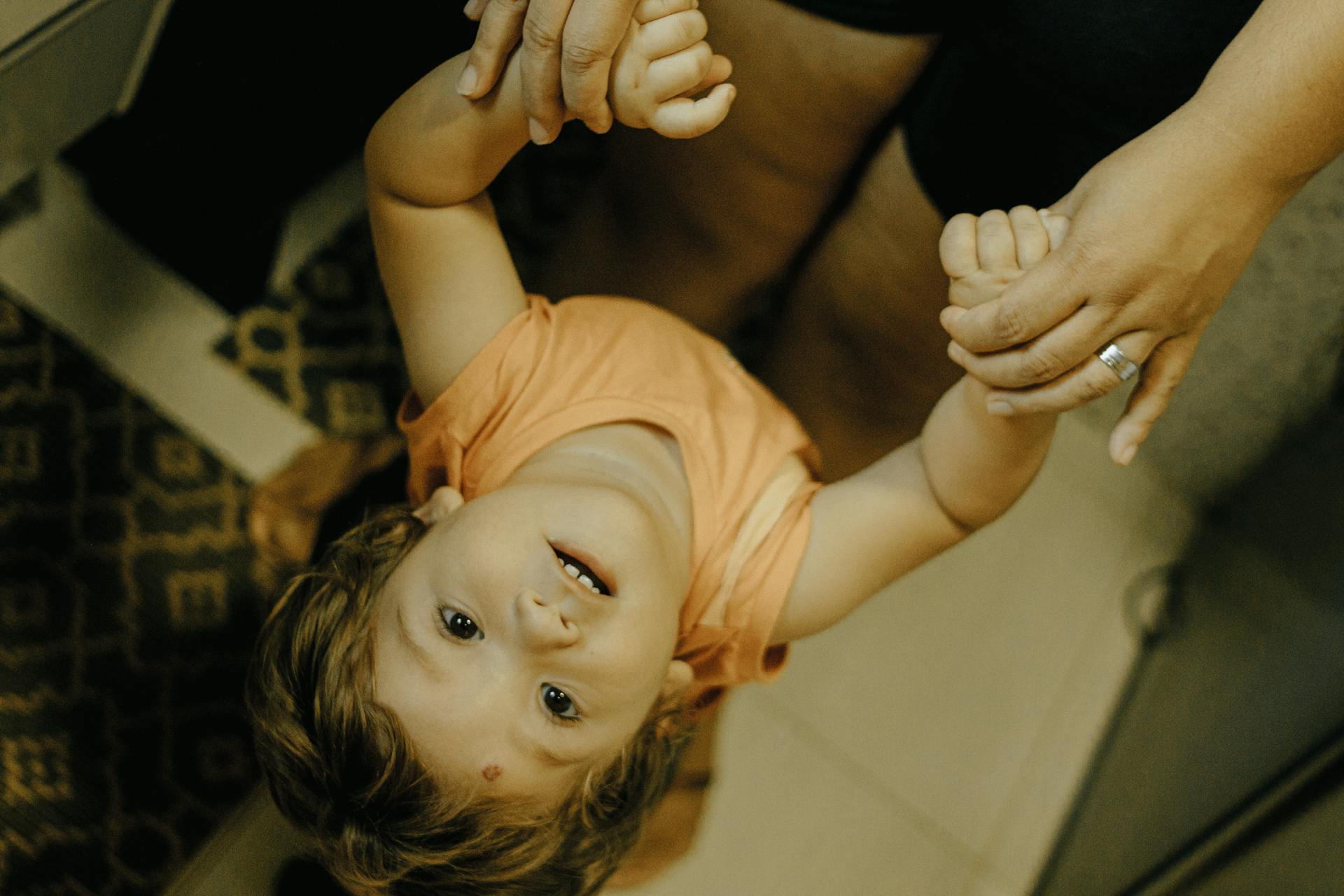
A Fidelity custodial account is a great way to save for your child's future. You can open one in your name as the custodian, and it's designed to help kids and teens build a strong financial foundation.
The account is designed for minors, typically under the age of 18 or 21, depending on the state.
You can transfer money into the account, and the funds can be invested in a variety of options, such as stocks, bonds, and mutual funds.
A fresh viewpoint: Mutual Funds Nre Account
What is a Custodial Account?
A custodial account is a specialized investment account created for minors to hold and manage assets under the supervision of an adult custodian.
A custodial account is a great option for minors to build up their wealth and assets gradually. The custodian, usually a parent or guardian, manages the investments and makes decisions on behalf of the minor until they reach the age of majority, typically 18 or 21, depending on the state.
UTMA accounts, also known as custodial accounts, offer versatility in terms of investment choices, allowing minors to invest in various securities, such as stocks, bonds, mutual funds, and more, through a financial institution that offers UTMA accounts.
If you're considering a custodial account, it's essential to consult with your attorney or a tax professional to help choose the best option for your situation. This will help you evaluate your goals, those of the child, and take stock of all your options to make sure that it's the right type of account for you.
For another approach, see: Custodial Account vs Utma
Opening and Managing a Custodial Account
You can open a custodial account through a quick online process, and anyone can contribute to it - parents, grandparents, friends, or other family members - with no contribution limits.
At Fidelity, the account will be restricted once the child reaches a certain age (between 18 and 25, depending on the state), and the custodian must transfer the account to the child within an allotted period of time.
You can transfer existing shares of stocks, mutual funds, or other securities from your own account into a custodial account, and there's no minimum to open an account, though certain investments may require a minimum initial investment.
Worth a look: Fidelity Minimum Balance Brokerage Account
How Custodial Works
A custodial account can be opened quickly online with no minimum to get started.
The adult custodian opens the account for a specific child, and can then add money to the account and choose investments.
Up to $18,000 can be contributed to a custodial account in 2024, free of gift tax, making them valuable gift opportunities for major milestones and celebrations.
There's no contribution limit, so anyone can contribute, including parents, grandparents, friends, and other family members.
Contributions of up to $18,000 in 2024 are free of gift tax, or up to $36,000 for a married couple.
The account will be restricted once the child reaches a certain age, and control has not been transferred to them.
The adult custodian must transfer the account to the child within a certain timeframe, which varies by state, typically between 18 and 25 years old.
At Fidelity, the custodian will be notified by the company when the transfer needs to be initiated.
A portion of the earnings from a custodial account may be exempt from federal income tax, up to $1,250 in 2024.
Any earnings in excess of the exempt amount may be taxed at the child's tax rate, which is generally lower than the parent's tax rate.
A different take: Custodial Account Tax Rules 2023
Opening a Custodial Account
A custodial account can be opened for a child in just a few steps, and it's a great way to save for their future. Anyone can contribute to a custodial account, with no contribution limits, making them a valuable gift opportunity for major milestones and celebrations.
At some financial institutions, like Fidelity, the account will be restricted once the child passes the state-mandated age and control has not been transferred. This is a mandatory process that must be initiated by the custodian.
The adult custodian opens the account for a specific child, and then can add money to the account and choose investments. The child's assets and control of the account must be transferred to them when they reach a certain age, generally between 18 and 25, varying by state.
You can transfer existing shares of stocks, mutual funds, or other securities from your own account into a custodial account, making it easy to get started. There's also no minimum to open an account, though certain investments may require a minimum initial investment.
Individuals can contribute up to $18,000 free of gift tax in 2024, or $36,000 for a married couple. This makes a custodial account a great option for saving for a child's education or other expenses.
You might like: Florida Custodial Account Age
Brokerage Considerations
UGMA/UTMA brokerage accounts can be a good option for saving and investing on behalf of a child, but it's essential to understand the implications.
Money put into a custodial account is considered an irrevocable gift, belonging to the child and subject to their control once they reach the age mandated by the state.
The gift tax may be a consideration, especially with the annual gift limit of $18,000 for individuals and $36,000 for married couples who elect to gift-split, starting January 1, 2024.
Earnings on the account are taxable, and income from investments is considered unearned income by the IRS.
For children, unearned income above $2,500 is taxed at the parent's rate in 2023, and if interest and dividend income comes to less than $12,500, the parent can include that income on their return.
Once the assets are transferred, the child can use them for any purpose, which may be a concern for parents who want to maintain some control over how the money is used.
Each state has different rules for determining when the child must take control of the account, so it's crucial to check the specific laws in your state.
Financial aid can be adversely affected by custodial accounts, as they are considered assets owned by the child.
You might like: Custodial Parent
Wait for Confirmation
After completing the necessary steps, wait for confirmation from Child Fidelity regarding the successful transfer process and the completion of the account transition. This confirmation is crucial to ensure the transfer is complete and the account is set up correctly.
The confirmation process usually takes a few days, so be patient and keep an eye on your email or mailbox for updates from Child Fidelity.
Consider reading: Transfer Brokerage Account to Fidelity
Keeping Your Name
Keeping your name as the custodian of a custodial account can be a good option if you want to maintain control over the account and its investments. This means you can make decisions that align with your financial goals and risk tolerance.
You'll have the freedom to monitor the account's performance and adjust strategies as needed, without interference from anyone else. This can be especially beneficial if you're comfortable making investment decisions on your own.
By keeping the account in your name, you can continue to make investment decisions that work best for you and your financial situation.
Closing the
Closing a custodial account can be a complex decision, requiring consideration of withdrawal limitations that may impact your access to funds.
Closing the UTMA account may be a viable option in certain circumstances, taking into account account withdrawal restrictions.
It's essential to review your overall financial goals before closing an account to ensure the decision aligns with your financial planning.
Considering sound asset management strategies becomes crucial when reallocating the funds from a closed account to ensure your investment portfolio remains diversified.
Closing an account requires a thorough review of your financial goals to avoid any potential negative impacts on your long-term financial wellbeing.
Suggestion: Demat Account Mutual Funds
Transferring Custody to a Child
Transferring custody to a child can be a straightforward process, but it's essential to follow the right steps. To transfer a UTMA account to Child Fidelity, parents or legal guardians need to contact the financial institution to initiate the transfer.
The process involves providing detailed information about the UTMA account, including the account number and the names of the current custodian and beneficiary. Child Fidelity will then guide the parent through the necessary paperwork that needs to be completed and submitted for the transfer to take place.
Transferring a UTMA account to Child Fidelity can provide numerous benefits, including diverse investment options tailored to fit the minor's financial needs and goals.
Intriguing read: Transfer Cash from Your Brokerage Account into Your Checking Account
Custodial Rights
You have the right to transfer the custodial account to the child at a certain age, which varies by state and can be between 18 and 25.
The custodian must initiate the transfer process, which can be done through the financial institution, such as Fidelity, that manages the account.
At Fidelity, the custodian will be notified when the transfer needs to be initiated, and they must transfer the account to the child within a specified time frame.
If the account is restricted due to a delay in transferring control, any restrictions will be lifted once ownership is transferred to the child.
The child will then have full control over the account and its assets, and the custodian's role will come to an end.
This process is mandatory and must be completed to ensure the child's access to the account's assets.
You can transfer existing shares of stocks, mutual funds, or other securities from your own account into a custodial account, making it a convenient option for managing a child's assets.

The adult custodian opens the account for a specific child and can then add money to the account and choose investments.
The child's tax rate, which is generally lower than the parent's tax rate, will apply to a portion of the earnings from the account, up to $1,250 in 2024.
Any earnings in excess of the exempt amount may be taxed at the child's tax rate, but you can contribute up to $18,000 free of gift tax in 2024, or $36,000 for a married couple.
Consider reading: Fidelity Tax Withholding Brokerage Account
UGMA Transfer to Child
Transferring a custodial account, also known as a UGMA/UTMA account, to a child can be a great way to save for their future and teach them about financial responsibility.
To start, you'll need to gather all the necessary information related to the account, including registration details and any required paperwork. This will ensure a smooth transfer process.
The account registration details you'll need to collect include the account number, beneficiary information, and custodial agreement. You'll also need to review any additional paperwork requested by the receiving institution.
As you begin the transfer process, you'll need to fill out the required transfer form accurately to avoid any delays or complications. This form will request important details such as the names and addresses of the minor and custodian, the account number, and the type of account being transferred.
Transferring a UGMA/UTMA account to a child typically involves contacting the financial institution to initiate the account transfer. You'll need to provide detailed information about the account being transferred, including the account number and the names of the current custodian and beneficiary.
The financial institution will guide you through the necessary paperwork that needs to be completed and submitted for the transfer to take place. This may include documentation such as identification for both the custodian and beneficiary, proof of relationship, and possibly a letter of intent.
By transferring a custodial account to a child, you can provide them with a wide range of investment opportunities and financial services, including tailored investment advice suited to their individual needs and risk tolerance.
You might like: Can Someone Check My Bank Account Balance with Account Number
Limited Investment Options

Transferring a UTMA account to a new custodian can come with limited investment options, which can hinder the ability to diversify and maximize returns.
This means you may not have access to specific account management tools or designations for beneficiaries, making it harder to manage investments within the transferred account.
It's essential to review new options and restrictions to make informed decisions about your investments.
Limited investment options can be a significant risk, especially if you're used to having control over your investments.
To mitigate this risk, consider alternative strategies to maintain control and maximize investment opportunities.
You can optimize your portfolio and achieve financial goals through proactive management and diversification strategies, even with limited investment options.
Changing Custodian
To change custodians, you'll need to contact the new custodian, in this case, Child Fidelity, to initiate the account transfer process. They'll guide you through the necessary paperwork and provide specific instructions.
You'll need to provide detailed information about the UTMA account being transferred, including the account number and the names of the current custodian and beneficiary. Child Fidelity will then help you complete the necessary documentation.
You may need to provide identification for both the custodian and beneficiary, proof of relationship, and possibly a letter of intent. This ensures a smooth transfer process.
Transferring a UTMA account to Child Fidelity can provide numerous benefits, including diverse investment options that support the minor's financial future. By moving the account, guardians can take advantage of the wide array of investment opportunities tailored to fit the minor's financial needs and goals.
You can also consider transferring the UTMA account to a different custodian, exploring account funding options, transfer processes, and the implications for the minor's financial future. This can give you more flexibility and control over the money.
To transfer the account, you can choose between directly transferring the assets or liquidating them and then transferring the cash. Each option carries its own set of considerations.
For another approach, see: Ugma/utma Custodial Account
Frequently Asked Questions
Is Fidelity a good custodial account?
Fidelity's custodial account is a good option for low-fee investing, offering commission-free trades and no minimum opening requirements. It's a solid choice for building wealth over time with a variety of investment options.
What is the age limit for Fidelity custodial account?
The age limit for a Fidelity custodial account is between 18 and 25, depending on the state, at which point the assets are transferred to the child. Typically, the child must be under 18 to open a custodial account.
What is the difference between Fidelity Youth and custodial account?
The main difference between Fidelity Youth and a custodial account is that Fidelity Youth is owned and managed by the minor, while a custodial account is owned and managed by an adult on behalf of the child. This gives teens more control and responsibility over their investments with Fidelity Youth.
What are the disadvantages of a custodial account?
A custodial account may limit a child's financial aid eligibility due to being considered an asset owned by the minor. This can impact a child's college financial aid package.
What happens to Fidelity Youth account when you turn 18?
When you turn 18, your Fidelity Youth account is automatically converted to a standard Fidelity brokerage account, keeping the same account number and login credentials
Sources
- https://www.fidelity.com/learning-center/personal-finance/custodial-account-for-kids
- https://www.fidelity.com/open-account/custodial-account
- https://www.fidelity.com/learning-center/personal-finance/can-kids-invest-in-stocks
- https://medium.com/millionaire-by-25/how-to-open-a-fidelity-custodial-account-e95d8727bdf0
- https://www.process.st/how-to/transfer-utma-account-to-child-fidelity/
Featured Images: pexels.com


